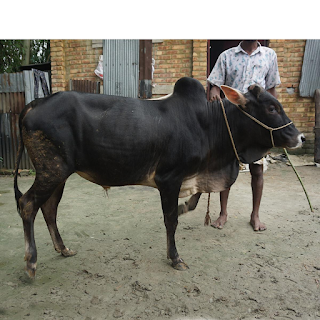What Color was the Indian Aurochs?
 |
| A Deshi bull with wild type coat color. Deshi is an interesting zebu breed for more reasons than one...but more on that later. |
So what could the coat colour of Bos namadicus have been like?
Well the base wild type coloration of taurine cattle, resulting form the E+ allele at the Extension locus, consists of dark nasal mucosa and a dark, eumalinized coat, usually with a narrow white area around the mouth and a light colored stripe on the back. This was known to be the exact coloration of at least some aurochs populations, and all wild cattle have a similar coat coloration as well; this being the case, it is probably safe to assume that E+ was the wild type Extension allele in the Indian aurochs as well. However, the story doesn't end there; the base wild type coat color can be modified by several genes at different loci which produce various light markings and colour dilutions. For example, the gaur and the banteng have white "stockings" and the banteng also has white rump patches; more relevantly, many taurine cattle have colour diluting alleles which can lead to suppression of eumelanin production on various parts of the body. In taurine cattle, this coat dilution often takes the form of a red colored saddle,stretching from the shoulders to the hips.

In zebu cattle, it seems the most common eumelanin dilution manifests as a broad band of red/brown on both sides of the animal
When pheomelanin production is inhibited, the diluted areas may appear grey
These are just a few examples of the effect which dilution alleles can have on the wild type coat colour in cattle, and we don't know whether any such alleles were naturally present, or even fixed, in the Bos namadicus population or not. It is not outlandish to believe they may have been, as dilution alleles are not found exclusively in domestic populations. It is known, based on preserved rock art, that at least some African aurochs bulls had red color saddles, for example. The kouprey also seems to have had dilutions alleles that produced a color pattern identical to that seen in some zebu. All that being said, I don't think there is particularly strong reason to suspect that the Indian Aurochs had light colored bands or any other such exotic markings. After all, many zebu show a wild type coat color with no coat dilutions, and I've posted some examples below:
 |
| A cattle market, probably in Bangladesh, showing black zebu bulls with buff, white and missing eel stripes. |
I think the coat color of Indian aurochs bulls was probably pretty much the same as those zebu bulls above; They were probably also sexual dimorphic in coat color, as wild cattle tend to be. The cows may have been colored similarly to the examples below
There seem to be a few subtle differences between the presentation of the wild type coat color in taurine and zebuine cattle. In zebu the extent of white on the mouth appears much more limited than in taurines, at least in mature bulls, and there is also a prominent patch of loose, naked skin around the legs in zebu. Zebu also have a lighter colored area behind the white on the muzzle. I strongly suspect that this area gradually darkens with age, at least in wild type bulls, but I'm not sure.
If the Indian aurochs was colored like the examples presented, then the Indian and European (sub)species would have been very similar in pelage. The small differences in pattern between zebu and taurines were probably also present between Indian and European aurochs. The color and presence/absence of the eel stripe varies in black colored zebu, and it probably did in the Indian and even the European aurochs as well. At the end of the day though, we do not currently have any direct evidence to support any coat color, no matter how exotic or conservative. For now, my best guess would be as described above. It would be an amazing breakthrough if cave art depicting the Indian aurochs with the clarity and detail of the paintings in Lascaux or Chauvet were to be discovered, but until then we can only make our best guess.
There seem to be a few subtle differences between the presentation of the wild type coat color in taurine and zebuine cattle. In zebu the extent of white on the mouth appears much more limited than in taurines, at least in mature bulls, and there is also a prominent patch of loose, naked skin around the legs in zebu. Zebu also have a lighter colored area behind the white on the muzzle. I strongly suspect that this area gradually darkens with age, at least in wild type bulls, but I'm not sure.
If the Indian aurochs was colored like the examples presented, then the Indian and European (sub)species would have been very similar in pelage. The small differences in pattern between zebu and taurines were probably also present between Indian and European aurochs. The color and presence/absence of the eel stripe varies in black colored zebu, and it probably did in the Indian and even the European aurochs as well. At the end of the day though, we do not currently have any direct evidence to support any coat color, no matter how exotic or conservative. For now, my best guess would be as described above. It would be an amazing breakthrough if cave art depicting the Indian aurochs with the clarity and detail of the paintings in Lascaux or Chauvet were to be discovered, but until then we can only make our best guess.
















Comments
Post a Comment